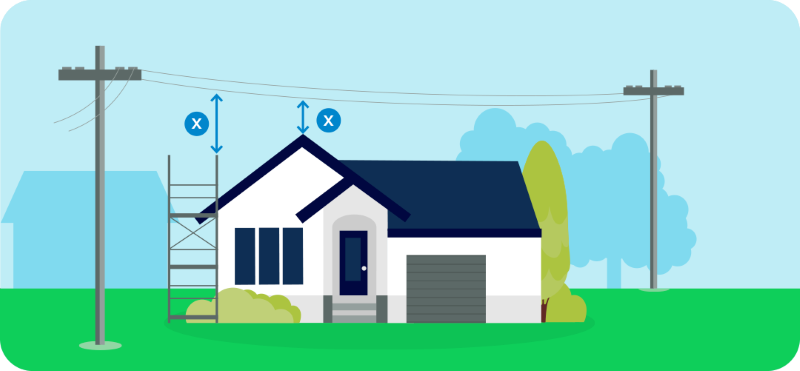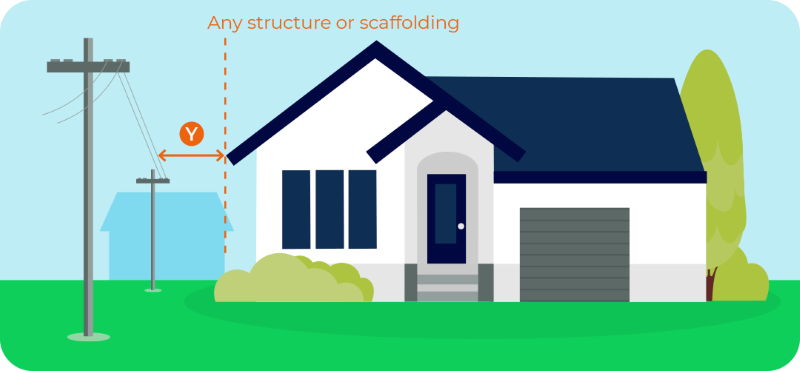Building, working or using mobile machinery near overhead lines or poles
Planning to build or extend? Know the rules around building near power lines.
What is NZECP34?
New Zealand Electrical Code of Practice for Electrical Safe Distances
Whether you’re a property developer, architect, surveyor, builder, scaffolder, roofer – or even a homeowner putting up a fence, sign, a marquee or laying a driveway – it’s important to know your legal obligations around building and working near power lines and power poles.
The purpose of NZECP34 is to protect people, property, vehicles and mobile plant from the risk of electrocution, serious injury and expensive damages or remedial works.
Confirming compliance with NZECP34 in the early stages of your planning is a must to ensure work near power lines and power poles can be done safely and to avoid any disruption to your plans or additional costs, such as changing architectural plans or relocating overhead power lines later.
As a result of Auckland Unitary Plan Change 78 you need to be more diligent about maintaining a safe distance for your planned construction. It is now even more important to know your obligations under NZECP34.
Remember: an approved resource or building consent does not mean compliance with NZECP34.
What does NZECP34 Cover?
NZECP34 covers all types of building and excavation - permanent or temporary - near power poles and lines, including but not limited to:
- Houses, extensions and other buildings
- Constructing and using scaffolding
- Portable buildings and marquees
- Building fences
- Digging/laying a driveway
- Raising ground levels
- Erecting signs and traffic lights
- Artificial shelter belts and canopies
- Use of cranes and Hiabs near powerlines
All work must be a safe distance away from overhead lines.
Failure to comply with NZECP34 could lead to prosecution by WorkSafe.
If you need to work closer to our overhead lines than permitted by the relevant minimum safe distances set down by NZECP34, you must apply for and receive a close approach consent from us in writing first.
Requirements for Buildings / Structures
- NZECP34 Section 3 requires that all new buildings and structures must maintain safe distances from the existing overhead powerlines. This includes extensions to existing buildings and scaffolding existing buildings
- The recommended safe distances for buildings and structures from the overhead powerlines are listed in NZECP34 Table 2 (replicated below).
- These distances differ depending on the voltage of the overhead powerlines. Our team can advise the powerline voltages.
- These distances are combined to form a rectangle, with measurements taken from the closest powerline (not the power pole).
- Only non-invasive measuring techniques should be used - do not attempt to touch the powerlines with any measuring tools.

Please refer to NZECP34, table 2 (replicated above) for the distances that apply at points ‘X’ and ‘Y’ in the diagram below in different circumstances.


Powerline movement engineering assessments
If your building or structure is or will be closer to the powerlines than the recommended safe distances, you will require a powerline movement engineering assessment
BEFORE your works can take place.
Requirements for operating mobile plant near overhead lines
- When you plan to work near overhead lines you must follow the minimum safe distances as set down by NZECP34.
- Follow the 4.0 metre rule when operating mobile plant: All mobile plant must be kept at least 4.0 metres from overhead lines
- If your mobile plant needs to get closer to our overhead lines, you must apply for a Close Approach Consent before starting construction.
Digging and excavation near power poles
- Do not dig within 5.0 metres of power poles or within 12.0 meters of towers without a Close Approach Consent.
- You will need to provide details on the size, depth and proximity of your excavation works in relation to the pole or tower to potentially receive a Close Approach Consent.
- Reminder: Do not deposit excavated materials under the powerlines. Excavated materials deposited under the powerlines decrease the ground clearances and creates a safety risk.